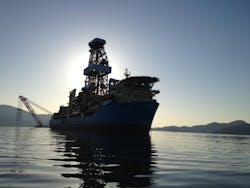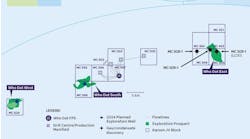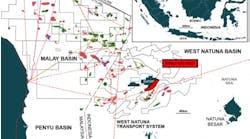SOUTHERN AFRICA is consolidating its position as an exploration hotspot. Recent activity led by the majors has confirmed Namibia’s long-suspected deepwater potential, building on TotalEnergies’ earlier successes with the drillbit off South Africa.
After decades of sporadic false dawns, exploration drilling off Namibia finally delivered earlier this year with two breakthrough oil discoveries. Shell’s Graff, reportedly containing up to 500 MMbbl recoverable, was quickly followed by the TotalEnergies-operated Venus, which some reports suggest could be one of the biggest fields discovered anywhere offshore Sub-Saharan Africa. Both are in adjacent blocks in the Orange basin, and were the first ultra-deepwater wells drilled anywhere offshore Namibia.
Prior drilling had focused mainly on targets in relatively shallow water. Texaco was the first operator to prove gas with its Kudu discovery in 1974 in 170 m (558 ft) of water in the northern Orange sub-basin, 130 km (81 mi) off Namibia’s southwest coast. Subsequent appraisal wells drilled by various other operators over the next 30 years confirmed Kudu as a 1.3-tcf resource, with potential for of up to 9 tcf, but at the time, the limited requirement for gas in the coal-generating southern African region deterred development.
Brazilian independent HRT was the first company to make a concerted attempt to test the basin’s deepwater Aptian play, drilling wells on three prospects in 2012-13. According to an article by Spectrum Geo, published in Offshore in April 2017, Wingat-1 and Murombe-1 both encountered thick (around 200 m/656 ft), mature Aptian source rocks, with the Wingat well also recovering light oil from several thin lenses within the Aptian interval. Although the result was sub-commercial, the wells proved the efficiency of the Aptian for generating oil, and the same source rock was encountered in other wells drilled further to the south of the Walvis basin along the Namibia and South Africa margin, including DSDP 361. Based on these results and other studies, geoscientists have determined that the Aptian source rock extends from Namibia’s Luderitz basin down to the southern margin of the Orange basin in South Africa. Graff-1 and Venus-1 were reportedly both designed to investigate Aptian targets.
The drillship Valaris DS-10 started drilling Graff-1 in the PEL-39 license off southern Namibia, 270 km (168 mi) from Oranjemund and in 2,000 m (6,562 ft) of water, early last December. State oil company NAMCOR, Shell’s partner (along with Qatar Energy) announced in February that the well had proven a working petroleum system with light oil, and that a further exploration well would likely follow to assess the possible extent and size of the discovery. Other reports suggested Graff-1 had been drilled in a slope channel system with a stratigraphic trap, encountering at least one 60-m (197-ft) hydrocarbon layer in an Upper Cretaceous sandstone reservoir. London-based E&P independent Tower Resources, which has interests in three offshore Namibia blocks 950 km (590 mi) to the north in license PEL 96 in the Walvis basin, speculated that the light oil had been generated in the Lower Cretaceous (Aptian-Barremian) or potentially older, deeper source rocks. It also appeared that the slope channel system with stratigraphic trap has enabled oil migration into a commercial-scale reservoir, with positive implications for other plays of the same type elsewhere off Namibia and South Africa.
Later in February, TotalEnergies announced a “significant” light oil/associated gas discovery in the Venus prospect in block 2913B. Venus 1-X, drilled by the Maersk Voyager drillship, reportedly in 3,000 m (9,842 ft) of water, intersected around 84 m (275 ft) of net oil pay within a good-quality Lower Cretaceous reservoir. TotalEnergies planned appraisal operations to assess commerciality, drawing on results from a coring and logging program. Contractual terms for the drillship include options for further wells. Other reports suggested Venus holds over 3 Bbl recoverable, much higher than pre-drill estimates, with another large prospect to the west on the same block that could be connected. If proven, this could warrant multiple development phases with several FPSOs, along the lines of ExxonMobil’s production line of projects in the Stabroek block offshore Guyana, but tailored to the much harsher environment in the offshore Orange basin. Philip Birch, Exploration Director of Impact Oil & Gas, one of the partners in block 2013B along with Qatar Energy and NAMCOR, said the play-opening Venus “firmly places the deepwater Orange basin as one of the world’s most exciting areas for hydrocarbon exploration,” adding that “the prospective Cretaceous oil and gas play extends to the east coast of South Africa.”
Other companies with acreage positions in the Orange basin have been monitoring these developments. Toronto-based Eco (Atlantic) Oil & Gas, which completed its acquisition of Namibian independent Azinam last month, has lined up the semisubmersible Island Innovator to drill the Gazania-1 well by October on block 2B offshore South Africa, 300 km (186 mi) north of Cape Town. According to partner Africa Energy the well will likely target two large prospects 7 km (4.3 mi) from Soekor’s 1988 light-oil A-JI discovery.
Although Tower’s Namibian blocks are a long way north of Graff-1, the drilling results are relevant, the company said, because its license area contains numerous prospects and leads in Cretaceous turbidites, Albian carbonates and early Cretaceous clastics, along with stratigraphic intervals that correlate with Lower Cretaceous rocks that are buried at a depth within the light oil window. Graff-1 has shown that these source rocks can potentially produce oil in sufficient quantities to charge large reservoirs, Tower added. One well drilled by Norsk Hydro on the company’s acreage in the mid-1990s recovered light oil from Albian carbonates.
As for Kudu, Namibia’s largest confirmed pure gas discovery to date, BW Energy is the latest operator to attempt commercialization as demand grows for gas-fired power in southern Africa. In 2021 the company closed a transaction with NAMCOR that increased its operated stake to 95% in the field and Petroleum Production License to 95%. BW Energy has been working on a gas-to-power development under which a semisubmersible drilling rig would be converted to a floating production unit (an agreement is in place to acquire the semisub West Leo from Aquadrill LLC). Repurposing should drive down capex costs compared to previous development concepts and deliver more competitively priced power to the local market, the company claims, with upside potential.
The African Energy Chamber, commenting on the Graff-1 discovery (prior to the Venus-1 result) said Namibia’s government must now take steps to develop an oil and gas bill to ensure effective regulation and provide certainty to investors. “The establishment and implementation of market-driven policies through an oil and gas bill,” the Chamber added, “will have a number of benefits, both for explorers and producers and the country itself. Firstly, the bill will improve certainty and transparency across the industry, providing IOCs and domestic companies clarity with regards to industry procedures and policies. This will ensure productivity while reducing time taken to get projects off the ground. Secondly, the bill will enable the regulation of the industry, providing clarity on tax, risk, ownership and safety, as well as environmental and local content policies.”
MOSSEL BAY BACKFILL OPPORTUNITY
In 2019-20 TotalEnergies also proved a new deepwater play in the Paddavissie fairway of South Africa’s Outeniqua basin, drilling the Brulpadda and Luiperd gas-condensate discoveries in Block 11B/12B, 175 km (109 mi) offshore the south coast. The company had made its first attempt on Brulpadda in 2014, but the well had to be suspended in 2014 due to problems encountered by the rig in the harsh deepwater (1,400 m/4,593 ft) environment. The Brulpadda-1AX re-entry well, drilled five years later by the Odfjell semisub Deepsea Stavanger, delivered 57 m (187 ft) of net hydrocarbons pay in Lower Cretaceous reservoirs, and further pay from a deeper objective. The subsequent Luiperd-1X well, in 1,800 m (5,905 ft) water depth, using the same rig, encountered 73 m (239 ft) of pay in a mid-Cretaceous reservoir interval. During the subsequent drillstem test, the maximum equipment-constrained flow rate was 9,820 boe/d. Drilling operations were again complicated by the harsh conditions, but TotalEnergies had anticipated these issues, drawing on its experiences as an operator west of Shetland in UK waters.
The Exploration Right for block 11B/12B expires this September, and the partners (which include Qatar Energy, CNR International and South African consortium Main Street) must apply for a Production Right to secure an extension. Vancouver-based Africa Energy, which has a 49% interest in Main Street), says the partners have been working on a Phase 1 development plan based on an early production system (EPS) and an environmental statement, with a view to agreeing sales gas terms. The EPS would focus on Luiperd, supplying gas through nearby offshore infrastructure to PetroSA’s 45,000-b/d gas-to-liquids plant onshore in Mossel Bay, which has reportedly been operating on a care and maintenance basis due to declining local gas reserves at shallow-water South African fields.
According to a report by IHS Markit, Luiperd and Brulpadda collectively contain over 5 tcf of gas. The initial priority for the EPS would be to confirm deliverability before adding more processing capacity downstream under a second-phase development. Facilities for the EPS could include a two-well subsea production system on Luiperd tied in to the Ikhwezi (F-O) platform, with new pipelines connecting to F-O and the offshore F-A platform. Phase 2 could produce up to 350MMcf/d, with the plateau rate potentially sustained to the mid-2060s, supported by development of Brulpadda.
In September 2020 Shearwater GeoServices completed processing of 2D seismic acquired earlier that year in the eastern part of block 11B/12B. Africa Energy later reported that analysis had revealed multiple potential prospects within the Kloofpadda play trend; and further processed 3D data received in 2021, based on surveys acquired by PGS and Polarcus, indicated the presence of more prospects in the Padavissie Fairway.




